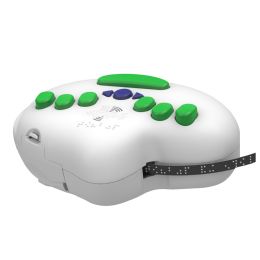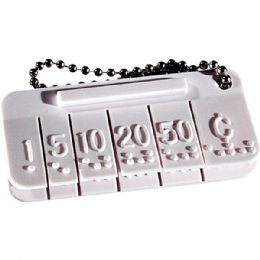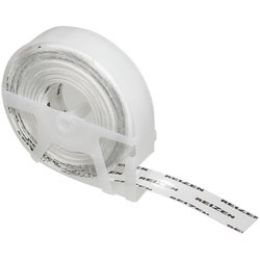


.jpg&newheight=260&quality=80)
For people with low vision or blindness, maintaining independence is important. Braillers are a great way to keep up communications with others; whether typing a letter, reading a book, or labeling items for everyday use.
What are Some Various Types of Braillers?
A braille typewriter has a key that corresponds to each of the six dots of the braille code, along with a space key, a line space key, and a back space key. It has two side knobs, like a manual typewriter, to advance the paper through the machine, and a carriage return lever above the keys. The Perkins Classic Brailler can emboss 25 lines with 42 cells on a single sheet of paper. It is also available with a brailler backpack that fits all Perkins Brailler models, with extra pockets for paper, cords and miscellaneous items. The backpack’s cushioned shoulder straps are adjustable in order for both adults and children to use it comfortably. Also available is a tape holder for the brailler, and an eraser made specifically for Perkins’ Braillers.
The Tatrapoint Brailler is a 6 key, mechanical brailler with adjustable left and right margins. It has special holders that are attached to the carriage to make it possible to tape. This brailler can print 34 characters/cells per line with 25 lines per page. It has an audible bell that sounds when the typist is 6 cells away from the end of the line. Also attached is a margin release key, a removable reading table, and rubber feet for non-slip usage.
The Duxbury Braille Translator is software which includes Nemeth Math Braille Translation. It also includes direct support for MS Word and WordPerfect, and braille translation for Spanish, French, and other languages. This translator for Windows allows a user to create accurate braille for office memos and textbooks, even if the user does not know braille. It can also translate print to braille and braille to print. The Duxbury Translator features a textbook layout, bidirectional grade 1 and grade 2 translation, and the American computer braille code. It also includes a 6 key chording technology, an interface that is compatible with speech output, and refreshable braille displays.
The 6dot Braille Labeler produces braille labels in any language. It highlights an ergonomic design to make it easy to use for adults and kids. The labeler can be used at home, or taken anywhere for braille label requirements. It embosses braille into an adhesive labeling tape and features a built-in braille keyboard that can emboss braille in any language. The USB port allows the ability to plug it into a QWERTY keyboard for an optional way to type, and runs on batteries to make it portable. The cutting of the labels is built-in, and the backing of each label is easy to remove. Simply type the label, print it, peel off the backing, and label the item to make it easy to find.
What are the Different Grades of Braille?
Braille is a system of raised dots arranged in cells, and any combination of one to six dots may be raised within each cell. The position and number of the raised dots within a cell tells the reader the letter, number, word, or symbol that cell represents. Within a single cell, there are 64 possible combinations of raised dots. There are 3 different grades of braille due to the varying needs of braille readers.
Grade 1 is the first grade of braille. Each possible arrangement of dots within a cell represents only one number, letter, punctuation sign, or special braille composition sign, giving it a one-to-one conversion. In this grade of braille, individual cells cannot represent words or abbreviations. Since this grade is unable to shorten words, books and other documents that are produced in grade 1 braille are larger and bulkier than normal printed text. Grade 1 braille is typically used only by those who are new to learning it. But, a new movement was in place in the early 2000s among elementary teachers of braille to introduce kids with sight difficulties to grade 2 braille right away after teaching the basics of grade 1.
Grade 2 braille began as a space saving option to grade 1 braille. A cell can represent a shortened form of a word in grade 2 braille. This is the most popular of the grades of braille because many cell combinations have been created to represent common words. There are part-word contractions which often stand in for common prefixes or suffixes. There are also whole-word contractions in which a single cell represents an entire commonly used word. Words may be abbreviated in several ways. One way is to use a single letter to represent the entire word. Other ways include using a special symbol to precede either the first or last letter of the word while cutting the rest of the word, using a double letter contraction such as ‘bb’ or ‘cc’, or removing most or all of the vowels in a word in order to shorten it. A complex system of rules, styles, and usage has been developed for this particular grade of braille.
Grade 3 is the last of the grades of braille and is basically a system of braille shorthand. It is not used in publications because it has not been standardized. Instead, it is normally used by individuals for personal convenience. It makes great use of vowel omission and contains over 300 word contractions. In addition, to shorten the length of the final document, the amount of spacing between words and paragraphs is decreased. And, sometimes it substitutes combinations of punctuation symbols for words.
Rehabmart is proud to offer innovative braille devices from experienced and superior quality vendors, including MaxiAids, LSS, and Proxtalker.
Hulet Smith, OT
Rehabmart Co-Founder & CEO
lb